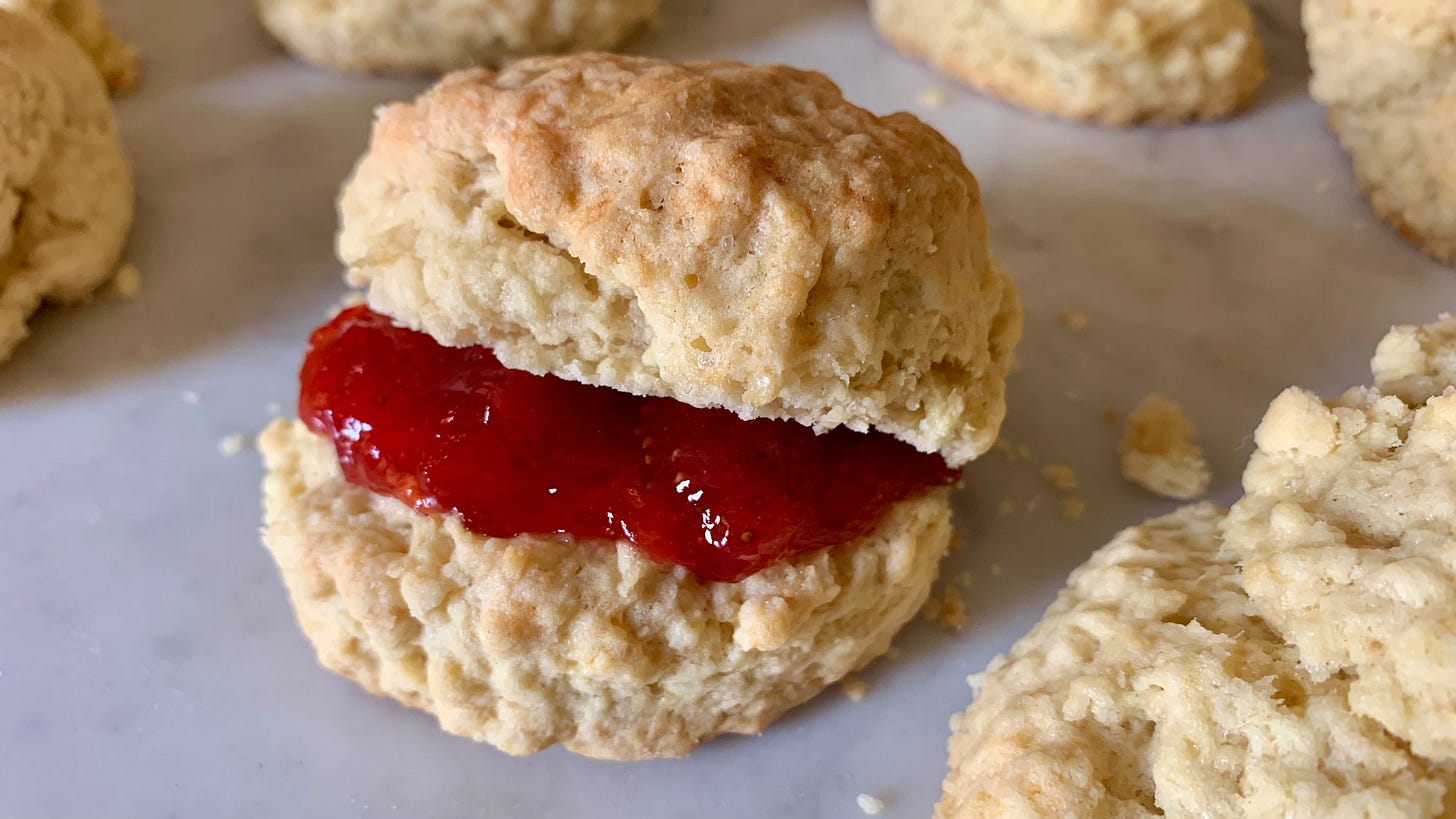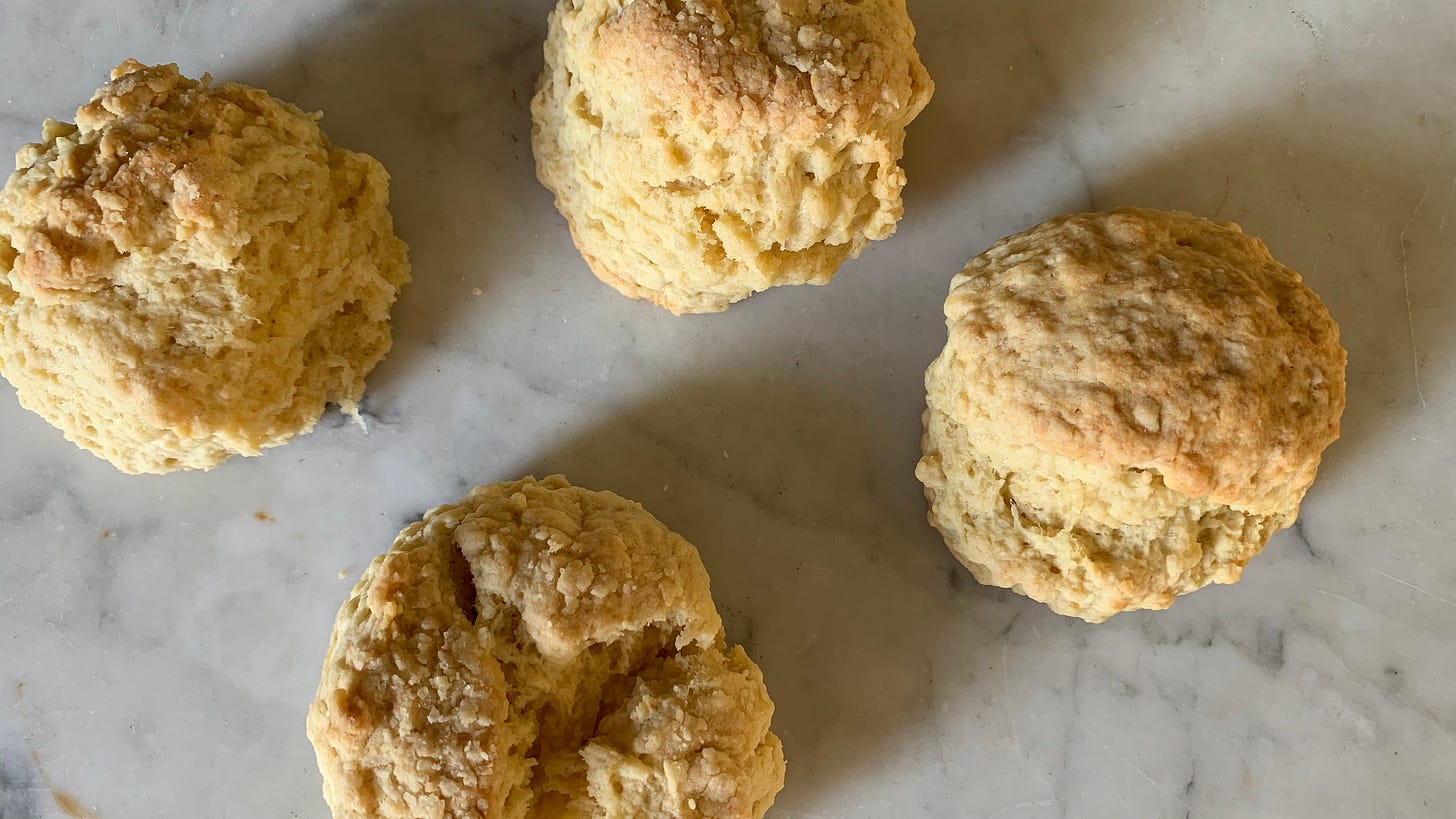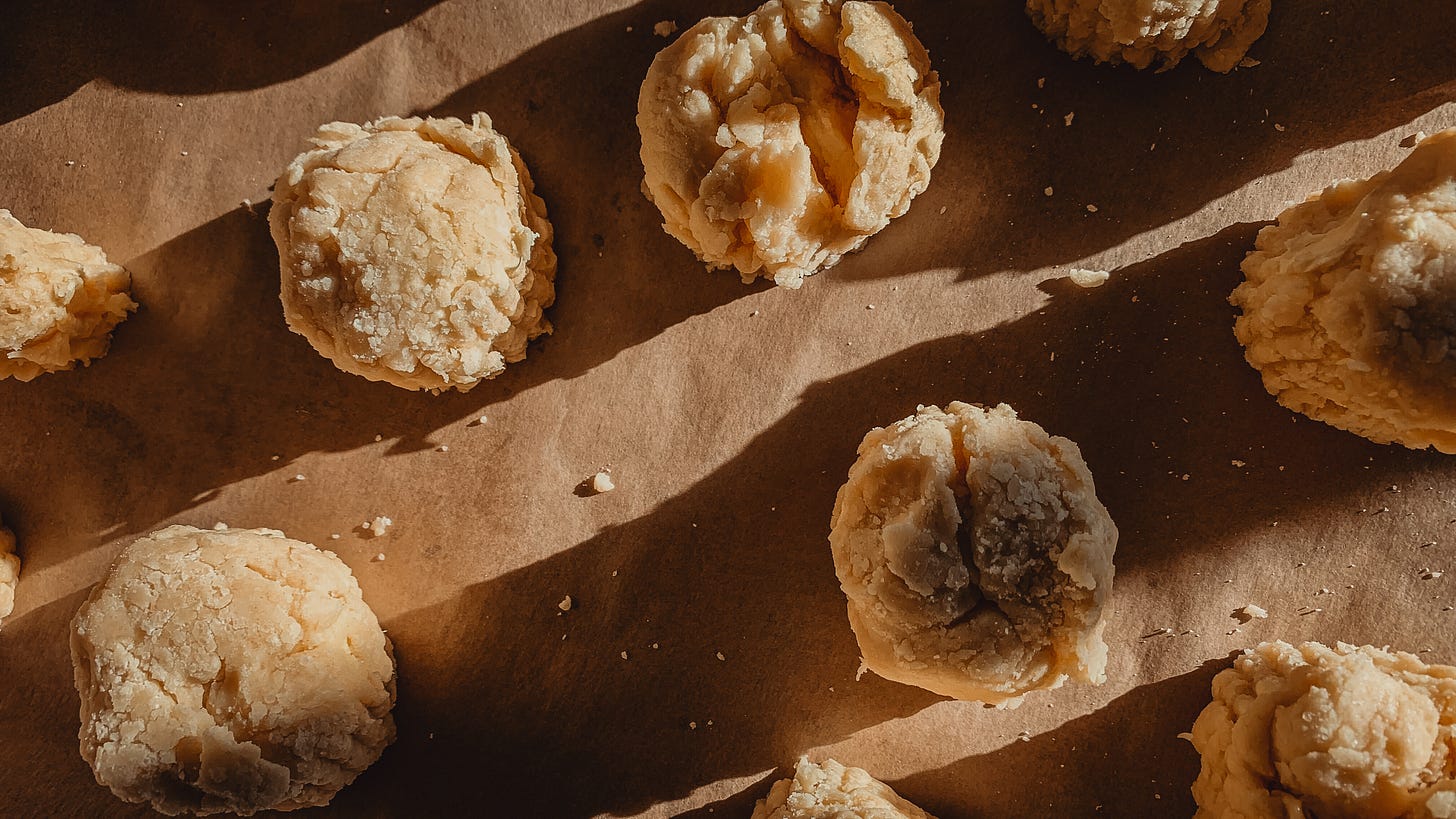I first met Kelly during a visit at Braziers Park, before I even started at the intentional community in Oxfordshire as a Kitchen Coordinator in late October of 2023. I noticed her jolly, yet calm energy and her passion for food right away.
A couple weeks later we had our first shift in the kitchen together, preparing lunch for the community.
And just like that Kelly threw together a batch of savory scones - adding nutritional yeast and a dried herbs blend to the dough. It took her 10 minutes, some flour here, butter there (and all the other ingredients that go into scones, of course), cutting to size, that’s it. No scale or measuring cups in use whatsoever.
I was very impressed. How did she do that?, I was wondering.
Kelly lives in a Caravan on Braziers Park estate. When I was visiting her one frosty afternoon in late November, I had to cross Braziers Park gardens and orchard (apple & pears) to get to her property: “I’ve always wanted my own house and several acres of my own property. Never have I thought I’d end up in a Caravan…!”
The Caravan rather feels like a cozy tiny house with its wood stove, big arm chair, the potted plants and kitchen nook. Over a ginger tea and some biscuits (cookies for my American readers), she shares her story with me.
Many years ago she was living and working at Braziers, responsible for the gardens, the greenhouses and growing organic produce that’s being used for the community and the many guests coming and going.
Some severe back pain forced her to leave Braziers Park however in order to recover. Feeling very sad about having to leave her home, she started traveling through Canada, a country she always wanted to explore further, since her sister lives there.
Earlier in her life, in her 20’s and 30's, Kelly spent many years in the states. Going back and forth between the UK an the US, she felt very much connected to Texas. Coming here initially for a summer kids camp, as a group leader, she kept going back in the following years.
Having several boyfriends and some serious relationships, too, she never felt she'd ever wanna live there, though. “... So I never got asked to marry.”, she said.
Now at 61 she's been back to Braziers Park for about 6 years, supporting a client with cerebral palsy part time and is cooking lunch for Braziers Park community once a week, occasionally supported by a volunteer.
Being part of a community means being part of anything that needs to happen and to be done, too, especially in an old English country house such as Braziers Park.
From gardening to maintenance to preparing the meals. No matter, if it’s only the community that needs to be fed, which is about 15-20 people, depending on how many are actually present for the meals. But oftentimes up to 35 or even 40 people, if there’s guests staying over the weekend for Workshops or Retreats.
Lunch and supper was clearly defined with what needed to be made and served:
Lunch usually was a hot vegetable soup and a big salad using preferably fresh ingredients from the green houses or the gardens served at 1 pm. Even in late November the abundance of greens and root vegetables was astonishing. I loved being out there and harvesting for the meals that I cooked.
Supper, served at 6:30 pm, was very British with its warm dish, usually a main dish with one or two sides (carbs and veggies) and the quintessential pudding, that is a dessert.
Since most people and also guests in the community are Vegetarians, some even vegan and gluten free, every dish was at least Vegetarian, too. I’ve had lots of Pies and Bakes that the UK is famous for. But having so many volunteers from around the world coming to Braziers, the variety of dishes ranged from Falafel to Spanish Frittata to Italian Lasagne as well.
Oh, and the pudding, I mean the dessert. Loads of custard sauce, syrupy spongy bake dishes or crumbles, stewed apples and pears or whatever ripened in the gardens. Imagine currants, raspberries and strawberries and even figs in the summer.
And Sticky Toffee Pudding. Oh my, sooooo good! Let me know if you want the recipe for that, too!
But back to scones… What are they actually?
Scones are often referred to as Scottish Scones, because they’re thought to originate from Scotland in the 1500s. Originally made using oats, they then were shaped and cut into wedges. The word scones has its roots in the Dutch (schoonbrot) and even the German language (sconbrot). Who would’ve thought.
In the 19th century scones turned into the British afternoon staple used for the English ritual ‘Afternoon Tea’ that many of us know and love today. Always served with (clotted) cream and jam, of course.
Making scones
Kelly was a calm and relaxed fellow to be around. I really enjoyed working with and learning from her. Observing her making scones, savory or sweet, gluten free or vegan, made me bow before her.
At Braziers she’d often make them in advance to have some sweet treat for the 11 am coffee break, elevenses. It is definitely a thing in Great Britain. Tolkien did not invent it just for The Hobbits. ;-)
Making scones is something that I’d tried in the past, using different recipes, some even from the UK, but alas failed many times. I never was able to reach the fluffy scrumptious texture that I love about scones. They often turned out very dense and dry.
Seeing Kelly doing her magic in not even using a recipe, but always winging everything, left me in Awe…
Of course I wanted to know how she does that!
I asked her to do something that she probably had never done before when making scones, measuring the ingredients before blending them together.
I literally forced her to weigh the flour that went into the bowl, every gram of sugar and butter, every cup of milk. What she’d written down for me on sketching paper isn’t an actual recipe, it’s a guide or a manual to make scones using a certain amount of each ingredient.
What’s not on that page is her guidance, teaching me how the texture, the consistency of the dough is supposed to be, and how it has to feel between your fingers.
For this Blogpost I remade Kelly’s recipe with the ingredients I had on hand, but without the guidance of Kelly. I think, they turned out great. Not sure, if they’d be Kelly-approved, though. ;-)
Kelly’s Scones - the ‘recipe’
600 grams (2 ½ cups) self raising flour (if you’re using all purpose flour or wheat flour, add 1 tsp baking soda and 1 tsp baking powder)
100 grams sugar (⅔ cups), I used cane sugar
1 pinch of salt
200 - 300 grams (¾ - 1 cup up to 1 ¼ cups or 2.65 sticks) of butter (or vegan butter)*
1 beaten egg
Approx. 100 ml dairy (a little less than ½ cup), I used oat milk
*The fat and liquid content in scones is crucial. Too much butter makes them lose their shape in the oven, too much liquid makes the dough too sticky. You want an almost crumbly, loose, but not too sticky dough.
Here’s the guidance I received from Kelly for making her scones (no)recipe:
Preheat your oven to 180 degrees Celsius (350 Fahrenheit). Prepare a baking sheet with parchment paper.
Mix all the dry ingredients (flour, sugar, salt, baking powder and baking soda, if using) together.
Cut the cold butter in slices/cubes and rub in with your fingers, but only so much so that the butter is blended in roughly. Think of German Streusel (crumbles). Start with 200 grams (¾ up to 1 cup) and add more at a time. 300 grams (2.65 sticks of butter) can already be too much and you’ll end up with cookies instead of Scones after baking them. You’d want them high enough to cut them in half.
Add the milk and egg. Mix in with a spoon or spatula. Start with a little bit of milk and add more, if needed.
Don’t overdo the mixing/blending in the wet into the dry ingredients, otherwise everything gets too warm and sticky and you’ll end up with the dense texture that I was speaking of earlier.
Using your hands form a rough block of dough, knead only briefly, if you must, and place it on your floured counter. Don’t do any more shaping or forming after that or otherwise the consistency becomes too dense. You want them fluffy! Approx. height of the block 5-7 cm (2-3”).
Using a fluted cookie cutter or a scones cutter with a ribbed edge (approx. 4.5 cm, little less than 2”) cut them to size and place on the prepared baking sheet.
Bake in the oven for 15 min, up to 20 min, depending on your oven.
Take out and let rest for 10 min. Cut in half and serve warm with clotted cream and/or jam.
Enjoy! :-)
In the next issue of Mel’s Treats we’ll fly over to Costa Rica where I met Jazz, a Canadian who got trained to be a Raw Vegan Chef and who spent several months on a cacao farm in Costa Rica before she taught me how to make divine chocolate treats using only a few ingredients.
Watch out for it in your inbox on February, 10th!







